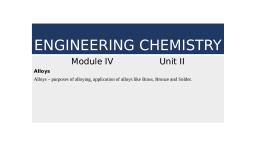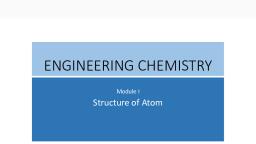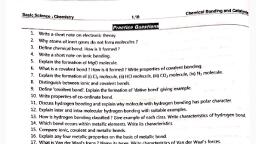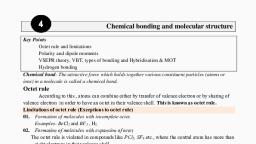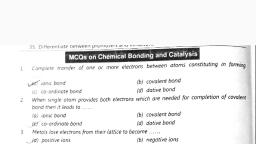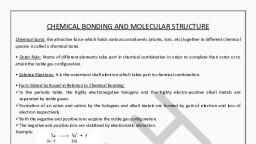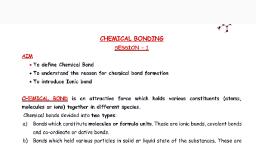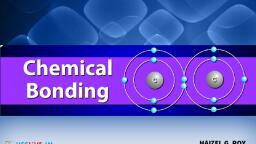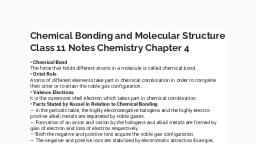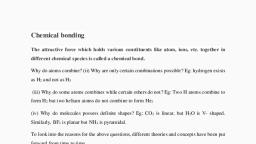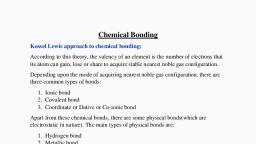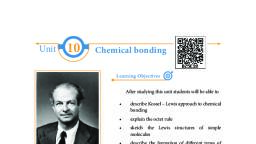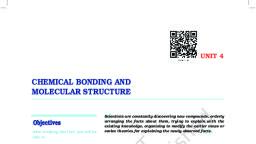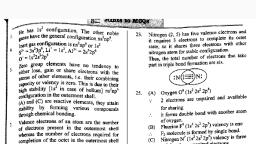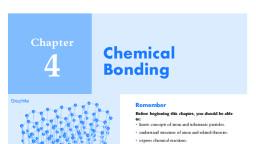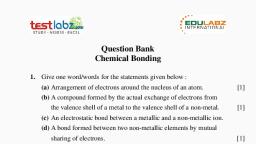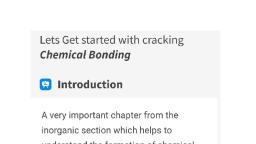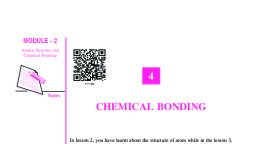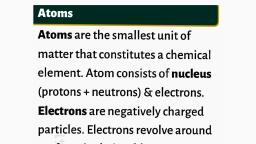Page 1 :
ENGINEERING CHEMISTRY, Module I, , Unit I, , CHEMICAL BONDING, Concept of chemical bonding – octet rule, Type of bonds:, i) Ionic bond (eg: NaCl), ii) Covalent bond (eg:H2, HF), iii) Co-ordinate bond in NH4+ ions, Anomalous behaviour of H2O due to hydrogen bonding.
Page 2 :
Chemical bonding, Octet rule, The octet rule states that atoms are most stable when their valence shells are filled, with eight electrons., The elements with eight electrons in their valence shell are known as inert gases or noble, gases. Usually they do not take part in chemical reactions or form compounds., Helium is an exception with only two electrons in the valence shell., 2He, , - 1s2, 2 2s2 2p6, 10Ne - 1s, 2, 2, 6, 3s2 3p6, 18 Ar - 1s 2s 2p
Page 3 :
Types of Chemical bonds, Ionic(electrovalent) bond, Ionic bond is formed by complete transfer of valence electrons from one atom to another. In, this process, the atoms involved get stability by attaining octet., A, , +, , B, , A+, , +, , B-, , The atom loses electrons gain a positive charge and the atom which receives electrons gain a, negative charge. The ions are held together by electrostatic force., Example, An electron from Sodium is transferred to Chlorine. By this process both the atoms gain octet., Na, 2,8,1, , +, , Cl, 2,8,7, , Na+ +, 2,8, , Cl2,8,8, , Ionic bond is formed between atoms with large electronegativity difference.
Page 4 :
Types of Chemical bonds, Covalent bond, A covalent bond is a chemical bond that involves the sharing of electron pairs between, two atoms. The shared electrons are known as bond pair., Covalent bond is formed between atoms with comparable electronegativity., , Examples, H2 molecule, HF molecule, , Electronegativity of Hydrogen is 2.2, while that of Fluorine is 4.0. Due to the, electronegativity difference the bond, pair is shifted more towards the, Fluorine. Thus HF is a polar molecule.
Page 5 :
Types of Chemical bonds, Coordinate bond, In coordinate bond, the pair of electrons shared between two atoms are donated by one of the atoms, involved in bonding., The atom that shares lone pair from itself is termed as the donor. The other atom which accepts these, pair of electrons using its vacant orbital and is known as acceptor. The bond is represented with an, arrow ,, pointing towards the acceptor., , For example, NH3 has a lone pair of electrons on Nitrogen., While H+ has 1s orbital vacant. A coordinate bond is formed, between the Nitrogen and Hydrogen. Nitrogen shares its lone, pair with Hydrogen ion.
Page 6 :
Types of Chemical bonds, Hydrogen bonding, Hydrogen bond is formed between Hydrogen atom of one covalent bond and an electronegative, atom involved in another bond., This type of bonding is formed when Hydrogen is bonded to an electronegative atom where, Hydrogen gets a partial positive charge and the electronegative atom gets a partial negative charge., , Hydrogen bonding in water, Hydrogen bond is represented by broken lines
Page 7 :
Types of Chemical bonds, Hydrogen bonding, Consequences of Hydrogen bonding in water, 1. Due to hydrogen bonding, more energy is required to overcome the interactions between water, molecules. Therefore the boiling point of water is high(1000C) and water exists as a liquid at room, temperature., 2. Due to hydrogen bonding, ice has honey comb like structure. It makes ice lighter than water., Therefore ice floats over water making life possible for aquatic organisms in cold regions., , The hollow structure of ice makes it to, float over water.
Page 8 :
Types of Chemical bonds, Review questions, , 1. What is octet rule?, 2. What is an ionic bond? Give an example., 3. What is a covalent bond? Explain with HF as an example., 4. What is a coordinate bond? Give an example., 5. What is a Hydrogen bond?, 6. What are the consequences of hydrogen bond?
